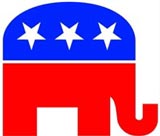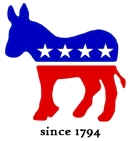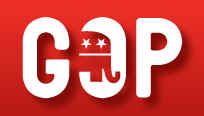
|
||||||||||||
|
|
|
The United States of America Political Parties
Federalist-The Federalist Party was a United States political party in the period 1793 to 1816, with remnants lasting into the 1820s. Opposition to Federalist stances led Jefferson and Madison to form the republican party , eventually becoming the Democratic-Republican Party. The Federalists controlled the federal government until 1801. The party was formed by Alexander Hamilton, who, in about 1792, built a network of supporters in the principal cities to support his fiscal policies. The Federalists were nationalists who wanted a fiscally and militarily strong nation state, and showed little interest in states' rights. The new party advocated a loose construction of the United States Constitution based on the "Elastic Clause". It believed in rule by a well-educated elite, and thus appealed to merchants, bankers, lawyers, editors, landowners, and industrialists; one of John Jay's favorite maxims was, "The people who own the country ought to govern it". Its most powerful leader was Hamilton and its hero was George Washington. The Party built a network of newspapers and had substantial support from religious leaders, especially in New England. The Democratic-Republican Party-The Democratic-Republican Party, founded by Thomas Jefferson and James Madison as the republican party in 1792, was the dominant political party in the United States from 1800 until the 1820s. The party and its members often identified themselves as the Republican party (not related to the present-day Republican Party), Republicans, Jeffersonians, Democratic Republicans, less frequently Democrats, or combinations of these (like Jeffersonian republicans). Jefferson and Madison created the party in order to oppose the economic and foreign policies of the Federalists, a party created a year or so earlier by Treasury Secretary Alexander Hamilton. Foreign policy issues were central; the party opposed the Jay Treaty of 1794 with Britain (then at war with France) and supported good relations with France before 1801. The Party insisted on a strict construction of the Constitution, and denounced many of Hamilton's proposals (especially the national bank) as unconstitutional. The party promoted states' rights and the primacy of the yeoman farmer over bankers, industrialists, merchants, and other monied interests. From 1792 to 1816 the party opposed such Federalist policies as high tariffs, a navy, military spending, a national debt, and a national bank. After the military defeats of the War of 1812, however, the party split on these issues. Many younger party leaders, notably Henry Clay, John Quincy Adams and John C. Calhoun, became nationalists and wanted to build a strong national defense.Meanwhile, the "Old Republican" faction led by John Randolph of Roanoke, William H. Crawford and Nathaniel Macon continued to oppose these policies. By 1828, the Old Republicans were supporting Andrew Jackson against Clay and Adams. Whig-The Whig Party was a political party of the United States during the era of Jacksonian democracy. Considered integral to the Second Party System and operating from 1832 to 1856, the party was formed to oppose the policies of President Andrew Jackson and the Democratic Party. In particular, the Whigs supported the supremacy of Congress over the Executive Branch and favored a program of modernization and economic development. Their name was chosen to echo the American Whigs of the 1770s who fought for independence. First Two-Party System
|
Federalists |
Republicans |
|
|
Second Two-Party System
Democrats v. Whigs, 1836 - 1850
Democrats |
Whigs |
|
|
The Republican Party - GOP (Grand Old Party) -The Republican Party was born in the early 1850's by anti-slavery activists and individuals who believed that government should grant western lands to settlers free of charge. The first informal meeting of the party took place in Ripon, Wisconsin, a small town northwest of Milwaukee. The first official Republican meeting took place on July 6th, 1854 in Jackson, Michigan. The name "Republican" was chosen because it alluded to equality and reminded individuals of Thomas Jefferson's Democratic-Republican Party. At the Jackson convention, the new party adopted a platform and nominated candidates for office in Michigan.
In 1856, the Republicans became a national party when John C. Fremont was nominated for President under the slogan: "Free soil, free labor, free speech, free men, Fremont." Even though they were considered a "third party" because the Democrats and Whigs represented the two-party system at the time, Fremont received 33% of the vote. Four years later, Abraham Lincoln became the first Republican to win the White House.
The Civil War erupted in 1861 and lasted four grueling years. During the war, against the advice of his cabinet, Lincoln signed the Emancipation Proclamation that freed the slaves. The Republicans of the day worked to pass the Thirteenth Amendment, which outlawed slavery, the Fourteenth, which guaranteed equal protection under the laws, and the Fifteenth, which helped secure voting rights for African-Americans.
The Republican Party also played a leading role in securing women the right to vote. In 1896, Republicans were the first major party to favor women's suffrage. When the 19th Amendment finally was added to the Constitution, 26 of 36 state legislatures that had voted to ratify it were under Republican control. The first woman elected to Congress was a Republican, Jeanette Rankin from Montana in 1917.
Democratic Party-Thomas Jefferson founded the Democratic Party in 1792 as a congressional caucus to fight for the Bill of Rights and against the elitist Federalist Party. In 1798, the "party of the common man" was officially named the Democratic-Republican Party and in 1800 elected Jefferson as the first Democratic President of the United States. Jefferson served two distinguished terms and was followed by James Madison in 1808. Madison strengthened America's armed forces — helping reaffirm American independence by defeating the British in the War of 1812. James Monroe was elected president in 1816 and led the nation through a time commonly known as "The Era of Good Feeling" in which Democratic-Republicans served with little opposition.
The election of John Quincy Adams in 1824 was highly contested and led to a four-way split among Democratic-Republicans. A result of the split was the emergence of Andrew Jackson as a national leader. The war hero, generally considered — along with Jefferson — one of the founding fathers of the Democratic Party, organized his supporters to a degree unprecedented in American history. The Jacksonian Democrats created the national convention process, the party platform, and reunified the Democratic Party with Jackson's victories in 1828 and 1832. The Party held its first National Convention in 1832 and nominated President Jackson for his second term. In 1844, the National Convention simplified the Party's name to the Democratic Party. In 1848, the National Convention established the Democratic National Committee, now the longest running political organization in the world. The Convention charged the DNC with the responsibility of promoting "the Democratic cause" between the conventions and preparing for the next convention.
As the 19th Century came to a close, the American electorate changed more and more rapidly. The Democratic Party embraced the immigrants who flooded into cities and industrial centers, built a political base by bringing them into the American mainstream, and helped create the most powerful economic engine in history. Democratic Party leader William Jennings Bryan led a movement of agrarian reformers and supported the right of women's suffrage, the progressive graduated income tax and the direct election of Senators. As America entered the 20th Century, the Democratic Party became dominant in local urban politics.
ROLE OF “THIRD” PARTIES
Despite broad political influence of the Democratic and Republican parties, so-called “third” parties and independent candidates remain a feature of American politics. Most third parties have tended to flourish for a single election and then die, fade, or be absorbed into one of the major parties.
There is evidence that third parties can have a major impact on election outcomes. For example, a third-party candidate might draw votes more votes away from the candidate of the party more closely aligned with to the position of the third-party candidate, thus enabling the other party to win the election – often without receiving a majority of the vote.
Public opinion surveys since the 1990s consistently have shown a high level of popular support for the concept of a third party. But in spite of such support for a third party, these parties face many obstacles. The most significant is the fear among voters that if they vote for a third-party candidate, they, in effect, will be "wasting" their votes. Voters have been shown to engage in strategic voting by casting ballots for their second choice when they sense that a third-party candidate has no chance of winning.





